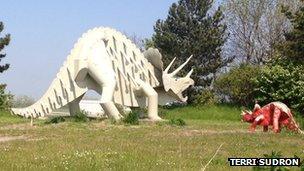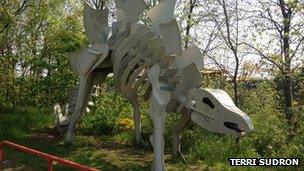Teesaurus dinosaur park faces extinction
- Published

The original Teesaurus cost £16,000
A screaming triceratops stands, mouth open, protecting her children in the industrial landscape of Middlesbrough's riverside.
She cannot move to bring her babies closer, even though they are being climbed on by juvenile homo sapiens.
That is because Teesaurus, as she is known, is a metal sculpture, created in 1979 as a tourist attraction.
And now in 2012 she faces the threat of extinction. Again.
Sue Martin, the woman behind the Facebook campaign Save our Dinosaur Park, external is leading a campaign to keep the park open.
She started the Facebook page after seeing a sign for the sale of the Teesaurus Park, near to St Hilda's on the southern bank of the river Tees.
Town's history
The housewife from Linthorpe, Middlesbrough, used to visit the park with her children.
She said: "It was a pleasant place to go, it had picnic benches and a space to play football until the council neglected it.
"I know lots of people who walk their dog there still, although it's in an industrial area it's still quite rural.
"The industrial landscape makes it so popular, the river Tees has always been popular with photographers and it's part of the town's history."
Middlesbrough Council said it needs to sell the land the dinosaurs are on as part of wider cuts.

Other dinosaurs joined Teesaurus in the park at Middlesbrough's riverside
A spokesman for the council said: "The Teesaurus Park site is one of a number of pieces of land around the town which are being offered for sale as part of our disposal of non-strategic assets.
"As and when a buyer is found for the site, the dinosaurs will either be relocated within the plot or a new home will be found for them elsewhere in the town."
The park first opened in 1979 when the council commissioned Teesaurus. The sculpture, designed by Genevieve Glatt, was made by workers on a youth training scheme at Harts of Stockton for £16,000.
It was later joined by a stegosaurus, brontosaurus and a mammoth, as well as other metal figures.
Mrs Martin said: "The Dinosaurs will attract people regardless, but it would be good to see them re-homed somewhere within the community.
"People really like them, hundreds of people have 'liked'' the page on Facebook, and there is talk of a petition going to MPs and Ray Mallon. We need to protect the park from extinction."
- Published23 October 2012
- Published8 January 2012